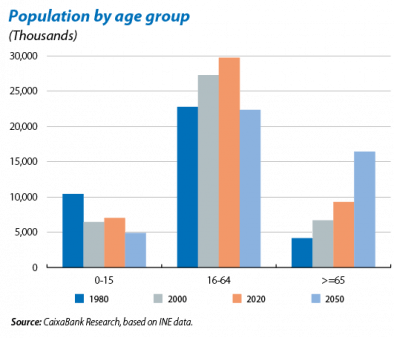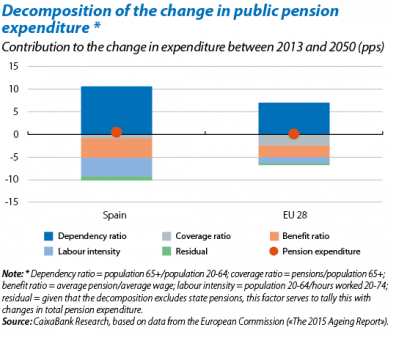The challenges of demography in Spain
Over the last few decades Spain's population has gradually got older. While 8.9% of the census was aged over 65 in 1971, this percentage had increased to 17.5% by 2015 and is expected to approach 20% by 2020. Such ageing will soon have a marked effect on economic growth and the main items within the welfare state, and could intensify over the coming years.1
According to the European Commission, projections for the driving forces behind demography suggest that populations are likely to continue ageing. The birth rate, which was 1.3% in 2013, will pick up slightly in the long term (up to 1.5% by 2050) but will remain below the rate of 2.1% required to replace the population. Between 2013 and 2050 life expectancy at birth will increase by 4.9 years for men and 4.4 years for women (up to 84.4 and 89.1 years of age, respectively). Over the same period it is estimated that the net migratory balance will be positive and might total half a million people although this will not be enough to offset the ageing trend. As a result, the dependency ratio for people over 65 (the share of the population aged over 65 compared with those of working age, between 16 and 64) will go from 27% in 2013 to 62% in 2050.
As has been described in detail in the article «Is the impact of the demographic transition inevitable?» in this Dossier, the effect of lower demographic growth and an ageing population on economic growth could be highly significant. In the case of the Spanish economy, the role played by demographics in growth has clearly changed when we compare its influence over the last few decades and its projected impact. Specifically, between 1980 and 2007 the working age population increased by 1.1% annually on average, to a large extent as a result of the baby boomers entering this group. Immigration also had a marked impact on this process, especially between 2000 and 2008 when the share of foreign workers increased by 3.0% to 15.5%. More women also joined the labour market (with the female participation rate rising from 27.8% in 1980 to 49.5% in 2007).
The outlook for the next few years is quite different. According to forecasts by the European Commission, on average the working age population will shrink by 0.6% annually between 2013 and 2050. One of the main reasons for this change in trend is that baby boomers are now aged between 50 and 55 and are therefore just about to retire. Among the different factors that could offset this situation, a priori, immigration is not expected to have such an impact as in the last few years partly because, given the large numbers coming to Spain in the past, the country is now one of the developed economies with the highest proportion of foreign population. However, the participation rate for women and the older population could help to cushion this change in trend in the working age population. In fact, in the short term the improvement in the economy and the recently approved reforms which aim to stimulate work among older people are likely to increase participation, a rise which would more than offset the reduction in working age population resulting from the baby boomers reaching retirement age. In this respect, the European Commission's projections expect the female participation rate (between 20 and 64 years of age) to go from 72.4% in 2013 to 78.6% in 2020, and the participation rate for older age groups (between 55 and 64 years of age) from 54.2% to 67.8%.
Nevertheless, in the longer term these mechanisms to counteract the ageing process will gradually reach their limit, which might lead to stagnation in the working age population. Given such a situation, growth in productivity would become even more crucial for the Spanish economy but recent trends are not promising: on average, total productivity factor growth was –0.7% annually between 2000 and 2014.2
The second great concern of demographic change is how it will affect the sustainability of the welfare state (see «How a greying population affects public spending» in this Dossier). One of the areas that cause most concern, and where most progress has been made in recent years, is the sustainability of the pension system. The reason is that an ageing population is a huge challenge in a distributive pension system such as in Spain, where the retirement pensions received in a period are funded by contributions paid by workers during the same period. In this case the expected rise in the dependency ratio could jeopardise the system if it is not adapted in line with demographic changes. An increase in the birth rate would help to offset the longer life expectancy but, as demographic dynamics are highly persistent, it would need to triple to maintain the dependency ratio constant.
Part of the solution lies in designing a pension system that adapts people's working lives to changes in their life expectancy. This is precisely one of the main achievements of the reform carried out in 2011. Note that, in spite of a very significant increase in life expectancy after 65 years of age (from less than 10 years at the beginning of the 20th century to almost 20 years at present), until the reform the retirement age had remained unchanged at 65 since it was first established in 1919 (via the General Regulation for the mandatory worker retirement scheme).3 In 2011 some of the pension system's conditions were altered to reduce the rate of growth in the number of pensioners by lengthening the working life of employees: a longer contributory period required to receive the maximum retirement pension and a gradual rise in the retirement age, from 65 in 2012 to 67 in 2027. Greater participation and employment rates among older people (one of the buffers for the effects of ageing on the working age population, as mentioned above) will help to partly offset the negative impact of ageing on the working age population and control the increase in the burden of pension expenditure caused by longer life expectancy (see the second graph).
In summary, demographic trends represent a considerable challenge for the economy as they are shrinking the working age population. However, there will be changes in the behaviour of the labour force due to the policies implemented, so that not all ageing will result in a smaller labour force and, consequently, in a loss of growth and an increase in public expenditure. Nonetheless, medium to long term projections are highly sensitive to small variations in the hypotheses used, so that any preventative measures will be more than welcome.
Maria Gutiérrez-Domènech
Macroeconomics Unit, Strategic Planning and Research Department, CaixaBank
1. See «The 2015 Ageing Report», European Economy 3/2015, European Commission.
2. See «The Conference Board Total Economy Database, Growth Accounting and Total Factor Productivity, 1990-2015».
3. See Conde-Ruiz and González (2010), «Envejecimiento: pesimistas, optimistas, realistas», Colección Estudios Económicos 10-2010 FEDEA.




